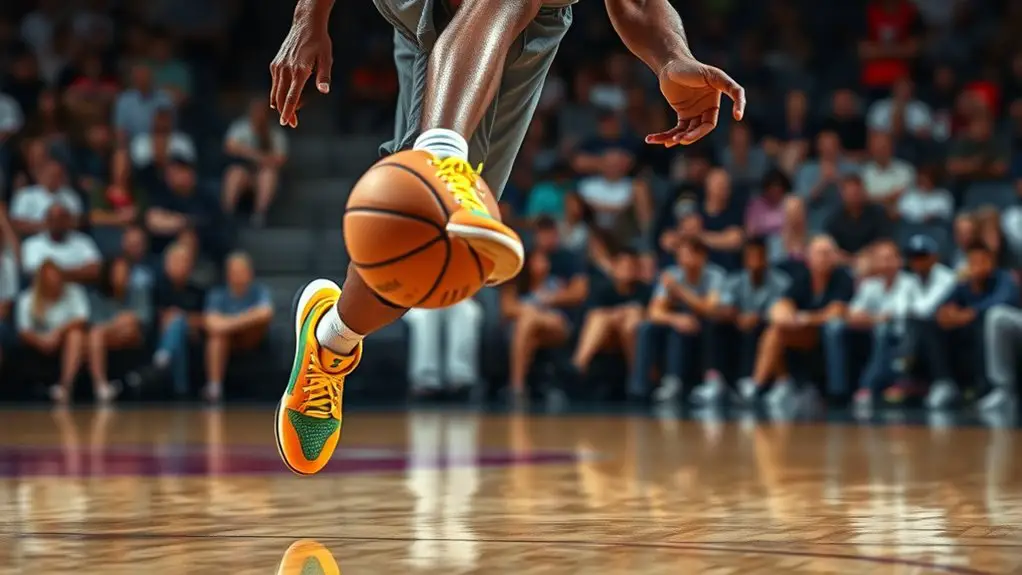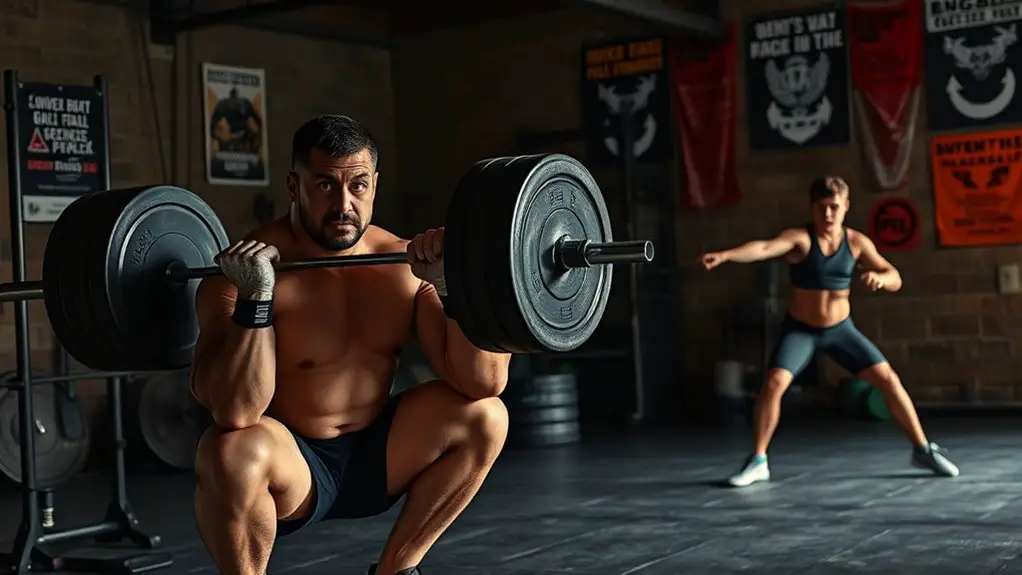Quarterbacks train for precision passing by honing their footwork, mechanics, and mental game. You'll focus on balance and agility drills to boost your speed and stability. Practicing your grip and stance will guarantee a smooth throw, while targeting drills sharpen your aim. Visualization and pre-game routines help build confidence and decision-making skills. Feedback and video analysis aid in refining your technique further. Discover how to simulate game situations for even more effective practice.
The Importance of Footwork in Precision Passing
While you might focus on arm strength and accuracy, footwork is just as essential for precision passing in football. Your ability to move fluidly and maintain balance can make or break a throw. Incorporating balance drills into your training not only helps you stay grounded but also enhances your overall stability during those critical moments on the field.
Agility training is equally important. By improving your foot speed and quickness, you'll find it easier to evade defenders while still keeping your eyes downfield. Imagine dodging an incoming tackle and delivering a perfect spiral; that's the freedom footwork can give you. Additionally, incorporating lateral movement drills can further enhance your ability to change direction swiftly and maintain balance.
Practicing these skills regularly will build muscle memory, allowing you to react instinctively during games. So, commit to refining your footwork, and you'll see how it elevates your passing game, giving you the freedom to execute plays with confidence and precision.
Mechanics: The Foundation of a Quarterback's Throw
When it comes to your throwing mechanics, grip and hand placement are essential for accuracy. You also need to focus on body alignment and footwork to guarantee a smooth release. Mastering these elements lays the groundwork for becoming a more precise passer. Additionally, incorporating strength training exercises into your routine can enhance your overall performance and stability on the field.
Grip and Hand Placement
Grip and hand placement are essential elements that can make or break a quarterback's throw. You've gotta master grip techniques to guarantee the ball feels secure in your hands. Find a grip that allows for both firmness and flexibility, letting you release your throw with confidence. Hand positioning plays a significant role, too; your fingers should have a comfortable spread on the ball, allowing for better spin and distance. Experiment with different placements to discover what feels most natural. Remember, the right grip and hand positioning can transform your throws from average to exceptional. Own your mechanics, and you'll find yourself connecting with your targets more consistently, giving you the freedom to play your game.
Body Alignment and Footwork
Body alignment and footwork serve as the backbone of a quarterback's throwing mechanics, ensuring your passes are accurate and powerful. Mastering balance exercises and making quick stance adjustments can elevate your game. Here's a breakdown of key elements to focus on:
| Element | Description | Impact |
|---|---|---|
| Stance | Feet shoulder-width apart | Enhances stability |
| Weight Distribution | Keep weight balanced | Improves throw accuracy |
| Foot Placement | Pivot foot aligned to target | Facilitates smoother motion |
| Follow-through | Full arm extension | Maximizes throw distance |
Mental Preparation: Building Confidence and Decision-Making
To excel on the field, you need more than just physical skills; mental preparation is key. By using visualization techniques, you can picture successful plays and boost your confidence. Game situation simulations also help you make quick decisions, preparing you for any scenario during a game. Incorporating mental imagery into your training routine can significantly enhance your overall performance.
Visualization Techniques
As you prepare for game day, incorporating visualization techniques can greatly enhance your confidence and decision-making on the field. Engaging in visualization exercises allows you to create mental imagery that simulates game scenarios, helping you react instinctively when it counts. Imagine every throw, every catch, and every play. This mental practice not only boosts your confidence but also sharpens your strategic thinking.
| Visualization Exercise | Purpose |
|---|---|
| Pre-Game Routine | Set your mental state |
| Throwing Mechanics | Improve technique |
| Game Situations | Prepare for pressure |
| Team Coordination | Strengthen communication |
| Post-Play Reflection | Learn from each experience |
Game Situation Simulations
While you might be focused on physical training, incorporating game situation simulations into your routine can greatly enhance your confidence and decision-making skills. By immersing yourself in realistic game scenarios, you'll learn to thrive in pressure situations. These simulations can help you:
- Develop quick, instinctive reactions
- Improve your ability to read defenses
- Enhance your communication with teammates
- Build mental resilience under stress
Practicing these scenarios not only sharpens your skills but also prepares you for the unpredictable nature of games. When you visualize yourself succeeding in high-pressure moments, you'll feel more confident during actual play. Embrace this mental preparation; it's key to revealing your full potential on the field.
Drills for Improving Accuracy
Improving accuracy in passing is essential for quarterbacks, especially when the game is on the line. To elevate your precision, focus on targeting drills that sharpen your skills. Set up various targets at different distances and angles, and aim to hit them consistently. You can use cones, buckets, or even teammates to create dynamic challenges that keep you engaged.
Incorporate accuracy challenges into your routine to push your limits. For instance, try throwing into tight windows or hitting moving targets while on the run. These drills not only enhance your aim but also build confidence under pressure.
Simulating Game Situations for Real-Time Practice
To truly elevate your passing skills, simulating game situations is essential for real-time practice. By replicating scrimmage scenarios and pressure situations, you can sharpen your instincts and decision-making. Here's how to make the most of your practice:
Simulating game situations is crucial for enhancing your passing skills and decision-making under pressure.
- Create game-like conditions: Use timers and scoreboards to track performance.
- Incorporate defenders: Adding defenders mimics the chaos of a real game, pushing you to think quickly.
- Vary the situations: Change the down and distance to keep you on your toes and prepare for any challenge.
- Include fans or noise: Simulating crowd noise can help you focus under pressure. Developing mental toughness is crucial for making precise decisions in high-pressure situations.
The Role of Feedback and Video Analysis in Development
As you work on refining your passing skills, the importance of feedback and video analysis can't be overstated. These tools create effective feedback loops that help you pinpoint areas for improvement. Video breakdowns allow you to dissect your throws frame by frame, revealing nuances you might miss in real-time. Additionally, incorporating biofeedback mechanisms can enhance your awareness of physiological responses that contribute to precision.
| Aspect | Feedback Loops | Video Breakdowns |
|---|---|---|
| Timing | Adjust release time | Analyze footwork |
| Mechanics | Correct throwing form | Evaluate follow-through |
| Decision Making | Review game scenarios | Understand reads |
| Consistency | Track performance | Spot patterns |
| Mental Approach | Reflect on mindset | Visualize success |
Utilizing these approaches empowers you to take control of your development, letting you embrace your style while honing your craft. By embracing feedback and video analysis, you're not just training; you're evolving.
Frequently Asked Questions
How Do Quarterbacks Choose Their Training Regimen?
When choosing a training regimen, you'll find that 80% of quarterbacks focus on specific skills based on their evaluations. You'll consider your training goals, like improving accuracy or footwork. Many players tailor their workouts to address weaknesses, ensuring a balanced approach. You might look at drills that enhance your throwing mechanics or decision-making under pressure. Ultimately, it's about finding what resonates with you and aligns with your aspirations on the field.
What Role Does Nutrition Play in a Quarterback's Training?
Nutrition's essential for your training, especially when you're aiming for peak performance. By implementing effective nutrition strategies, you can fuel your body for intense workouts and recovery. Meal timing also plays a significant role; eating the right foods before and after training can enhance your energy levels and muscle repair. So, prioritize your meals to keep your body in top shape, and you'll notice the difference on the field.
How Often Do Quarterbacks Practice Passing Drills?
Imagine a sculptor chiseling away at marble, shaping their masterpiece with precision. That's how often quarterbacks engage in passing drills—multiple times a week, refining their skills with relentless dedication. Their passing frequency varies, incorporating different drill variations to keep their practice fresh and dynamic. It's about embracing the freedom to explore techniques, ensuring they can adapt under pressure, and crafting each throw like a work of art in motion.
What Injuries Are Common Among Quarterbacks During Training?
When you think about the common injuries quarterbacks face during training, shoulder injuries and wrist sprains often come to mind. These injuries can happen due to repetitive throwing motions or improper mechanics. You might feel the strain on your shoulder after intense practice sessions, while wrist sprains can occur from awkward throws or falls. Staying aware of your body and focusing on proper technique can help you avoid these setbacks and enjoy your training.
How Can Young Quarterbacks Find a Mentor for Training?
Finding a mentor isn't just luck; it's a strategic move. You can start by exploring mentorship programs in your area. Local camps often feature experienced coaches and former players who're enthusiastic to share their knowledge. Don't hesitate to reach out to high school coaches or join community leagues—they're great resources. Engaging with these networks not only hones your skills but also connects you with valuable guidance that can elevate your game.




